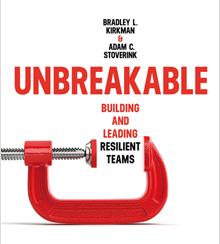The four qualities of resilient teams
A new book examines successful teamwork in the digital age.

Unbreakable: Building and Leading Resilient Teams
by Bradley L. Kirkman and Adam C. Stoverink (Stanford University Press, 2023)
Teamwork is trending—and probably always will be. But managing teams isn’t getting any easier.
Business leaders are still coping with the unprecedented dispersal of staff prompted by covid and enabled by technologies such as Zoom. Although some people are back in the office, many prefer to work remotely, at least part of the time. It appears that the traditional, office-based 9-to-5 is probably a thing of the past.
Even before covid, though, teams were increasingly made up of ever more diverse staff members in ever more far-flung locales. Managing and coordinating across time zones and cultures can be a challenge, and that’s before we consider how to motivate team members and build them into a cohesive unit when they spend little time working in physical proximity.
Those challenges are important for several reasons, not least because in business, as in life, things go wrong. In Unbreakable: Building and Leading Resilient Teams, Bradley Kirkman and Adam Stoverink, business professors at North Carolina State and the University of Arkansas, respectively, tackle the problem of how to gird your team against the setbacks that disrupt operations—or worse.
Teams have great potential advantages in the face of setbacks. The talent, energy, and resources of a group will always exceed those of an individual, and group members can support one another in a crisis. But the point of a team is to accomplish ends sufficiently challenging and complex that a whole bunch of people must work together. That means coordination, communication, and, potentially, friction. Teams also need some things that tend to be in tension with one another. They need leadership, for example, yet they need personal initiative to make decisions close to the action. Teams also need to strike just the right balance between planning and improvisation.
Doing all this is infinitely harder when things go bad. The authors open their book with a bang by focusing on the tragic case of the 1949 Mann Gulch Fire in Montana’s Helena National Forest, which claimed the lives of 13 wildland firefighters and was the subject of Norman Maclean’s famous book, Young Men and Fire. Fighting fires is teamwork, but when the fire turned viciously against the team sent to corral it, inadequacies in planning compounded by breakdowns in communications, confidence, and other essential factors led to disaster.
Business, thankfully, isn’t usually quite that risky. But there are steps managers can take to increase team resilience. “Over the past two decades of working with thousands of teams from hundreds of companies,” the authors write, “we’ve found that when adversity strikes, resilient teams do three specific things exceptionally well. They are skilled at making sense of situations, they coalesce, and they persist.”
When adversity strikes, resilient teams do three specific things exceptionally well. They are skilled at making sense of situations, they coalesce, and they persist.”
Much of the book is spent on the four qualities the authors believe teams must cultivate to achieve resilience.
The first quality is team confidence, or the belief that the team can handle just about anything that comes its way. Team confidence, the authors note, isn’t really the sum of a lot of individual confidence, for swollen egos don’t benefit the team. The goal is collective and mutual confidence. And not too much, because overconfidence undermines success. “Moderately high confidence offers a healthy balance of confidence and caution,” the authors write.
To build team confidence, managers are urged to make goals and processes clear, empower the team by encouraging members to participate in decision-making, cheer successes, and provide useful feedback during struggles.
The second quality is having the foresight to create a teamwork road map, or a plan that “reflects the extent to which all team members know what their own roles and responsibilities are, and the extent to which they agree on what all other team members’ roles and responsibilities are. Team members may even know how to perform one another’s roles so that at any point, one person can step in for another.”
Throughout the book, in fact, the authors stress the importance of preparation in building resilience. For example, teams should run through brief practices to determine how they will cope with the absence of each member to accomplish their goals. Who will step up? What knowledge will they need to do so? Backups should be designated in advance so that they can step in as needed.
The third quality is the capacity to improvise. Recommendations here include making sure members understand who knows what so they can call on colleagues with the right knowledge; assembling teams “with a high level of thought diversity;” and making sure team members are comfortable sharing.
The fourth quality is valuing the team’s psychological safety. The authors want team members to speak up with suggestions, observations, and objections without feeling shy or intimidated. At times, their concerns in this arena border on obsession. The words safe and safety appears in the book 247 times, by my count, as if readers might be engaged in professional activities as dangerous as firefighting rather than merely rejiggering spreadsheets and sitting through video calls.
That said, the authors are at least well attuned to the importance of psychology in team success. They emphasize the importance of morale, of making sure the team knows the impact it is having, and of praising worthy efforts. Team members can even visit other teams and customers via video call to explain the importance of their work. Managers are urged to ask team members how they are doing and hold one-on-one check-ins. One of their best suggestions is to have a daily 15-minute huddle, which must seem like bliss compared to the endless meetings that have come to afflict the modern workplace.
A resilient team will overcome difficulties to get the job done, and when it succeeds in the face of adversity, it can draw on this experience to perform even more successfully in future. To help this process along, the authors urge teams to follow up projects with debriefing sessions during which all parties meet to list “roses” and “thorns” on a whiteboard. The thorns come first because the roses, after all, are easy. And everyone looks forward to reveling in their fragrance.
Author profile:
- Daniel Akst is a business writer, author, and novelist based in New York’s Hudson Valley. His books include Temptation: Finding Self-Control in an Age of Excess.





